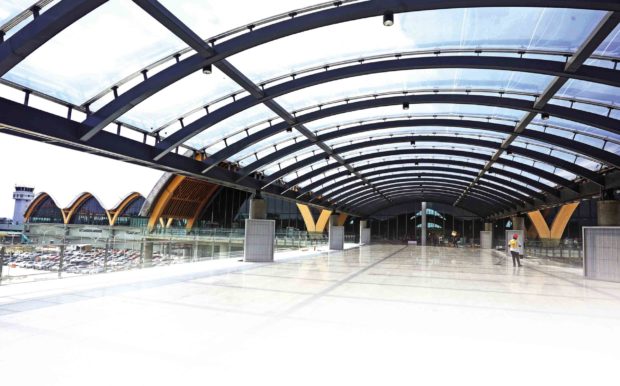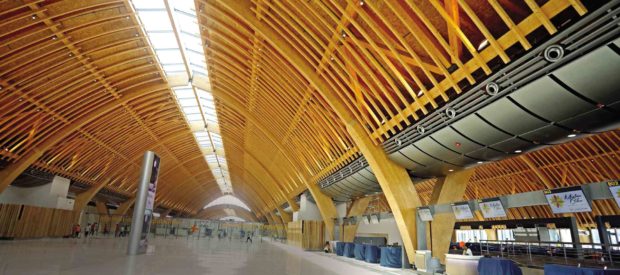More than a gateway to Cebu
Beauty and luxury. These words best describe what 26-year-old Keeshia Salazar thinks of the new Terminal 2 of Mactan-Cebu International Airport (MCIA).
“The new terminal is spacious. It’s well-designed, aesthetically that is. I like the fact that it’s clean and it really gives you that luxurious feeling. It’s a beautiful structure, albeit it can be lacking in a few things,” said Salazar, a lawyer.
She and some relatives were able to experience the world’s first resort airport terminal when they traveled to Bangkok on Aug. 21 for a vacation.
But just like most new facilities, Salazar said MCIA Terminal 2 could still be improved on.
“The staff should be clear as to what steps to take first and where to go. It’s a new place, I think people are still adjusting. So it would be helpful to have people not just standing or sitting there but actually take an active role in guiding people where to go,” she said.
Foreign tourists also enjoy the P17.5-billion facility.
Airport officials have noted a spike in the number of visitors from other countries following the July 1 opening of Terminal 2.
Hotel, resort occupancy
Local tourism players are already seeing the benefits of the terminal.
Hotels and resorts have posted higher occupancy rates following the influx of more tourists.
Carlo Anton Suarez, president of the Hotel Resort and Restaurant Association of Cebu, said members of his group had been enjoying at least 80-percent occupancy rates in the past three months. For June to August 2017, Suarez said the occupancy rate was at most only 70 percent.

PASSENGER GUIDE Signages are prominently placed at Terminal 2 to guide passengers. LITO TECSON/CEBU DAILY NEWS
“Our average occupancy rates in the past three months is higher than the same time last year,” he said. Suarez attributed it to the increase in direct international flights to Cebu with the new terminal.
Terminal 2 is exclusive for international flights and is expected to cater to 8 million passengers a year.
Based on records from GMR-Megawide Cebu Airport Corp. (GMCAC), private operator of MCIA, both passenger traffic and air traffic movement for July 2018 significantly increased compared with the same month last year.
International passenger traffic in July was at 364,199, or a 43.54-percent increase from the 253,719 posted for the same period last year.
Air traffic movement in July was pegged at 2,415, or 33.06 percent higher than the 1,815 recorded for the same month in 2017.
More international flights
GMCAC president Louie Ferrer said 15 direct international flights to Cebu had been added since January.
“Of that number, 12 are from different parts of mainland China. So we see the Chinese tourists as a big market,” Ferrer said.
Philippines AirAsia launched three new routes out of MCIA to Chinese destinations—Hangzhou, Shenzhen and Shanghai earlier this year.
Philippine Airlines’ subsidiary, PAL Express, also resumed its Cebu-Chengdu service on May 8 and mounted charter flights to Hangzhou and Nanjing in July.
Cebu Pacific began charter flights to Shanghai thrice a week and to Beijing, twice a week.
Foreign airlines like Okay Airways also kicked off its thrice-a-week Cebu-Changsa-Cebu route in June. Royal Air Charter Service Inc. commenced its nonscheduled, daily charter services from Cebu to Macau in the same month.
Ferrer said his group would continue to market Cebu to different cities and provinces in China, as well as to Japan, Australia and other countries.
“We don’t sell the airport because it is just a gateway. We are selling Cebu. We are selling Lapu-Lapu City and the rest of the Visayas and Mindanao areas,” he said.
Secondary cities abroad
While it is not closing its doors on bigger cities in China and other countries, GMCAC plans to target secondary cities abroad and establish flights going to Cebu, Ferrer said.
This is because major cities will usually eye Ninoy Aquino International Airport in Metro Manila, he pointed out.
The Department of Tourism (DOT) in Central Visayas is also actively partnering with GMCAC in its tourism marketing initiatives for the region.

The spacious entrance to Mactan-Cebu International Airport’s Terminal 2 —LITO TECSON/CEBU DAILY NEWS
Shalimar Tamano, DOT regional director, lauded the aggressive marketing efforts of the airport operator, calling it a win-win setup for both parties.
“GMCAC is a business. In running an airport, it has to have more airlines. The more airlines, the better the business. For us, GMCAC has become sort of a marketing and promotions arm for Cebu. It’s traveling all over the world convincing airlines to fly to MCIA Terminal 2,” he said.
Addressing concerns
Tamano said GMCAC visited four cities in India, including Mumbai and New Delhi, on Aug. 26 to convince airlines to open routes from these cities to Cebu.
While marketing efforts have been fruitful, the tourism official acknowledged the concerns and complaints raised during the nearly two months’ operations of Terminal 2.
Among these were the overflow of rainwater in the link bridge, which connects the departure drop-off area to the actual terminal, on July 31.
Several airlines have also sought the availability of ground personnel during arrival and departure.
“These are birth pangs that we have to understand. Airport officials decided to open the Terminal 2 even if it was not fully finished. But if you want it to be perfect, it would take a long time,” Tamano said.
Spanning 65,500 square meters, Terminal 2 is expected to increase the total capacity of MCIA to 12.5 million passengers a year, including Terminal 1 (for domestic passengers).
GMCAC earlier reported that MCIA served a total of 5.76 million passengers, both domestic and international, for the first half of the year.
From January to June, MCIA recorded 3.87 million domestic passengers while international traffic totaled 1.89 million.
Domestic and international passenger traffic increased by 10.19 percent and 17.54 percent, respectively, from figures in the first half of 2017.
This year, GMCAC has set a target of 11.2 million passenger traffic.
With their current numbers, Ferrer said the company was optimistic in hitting this target.
